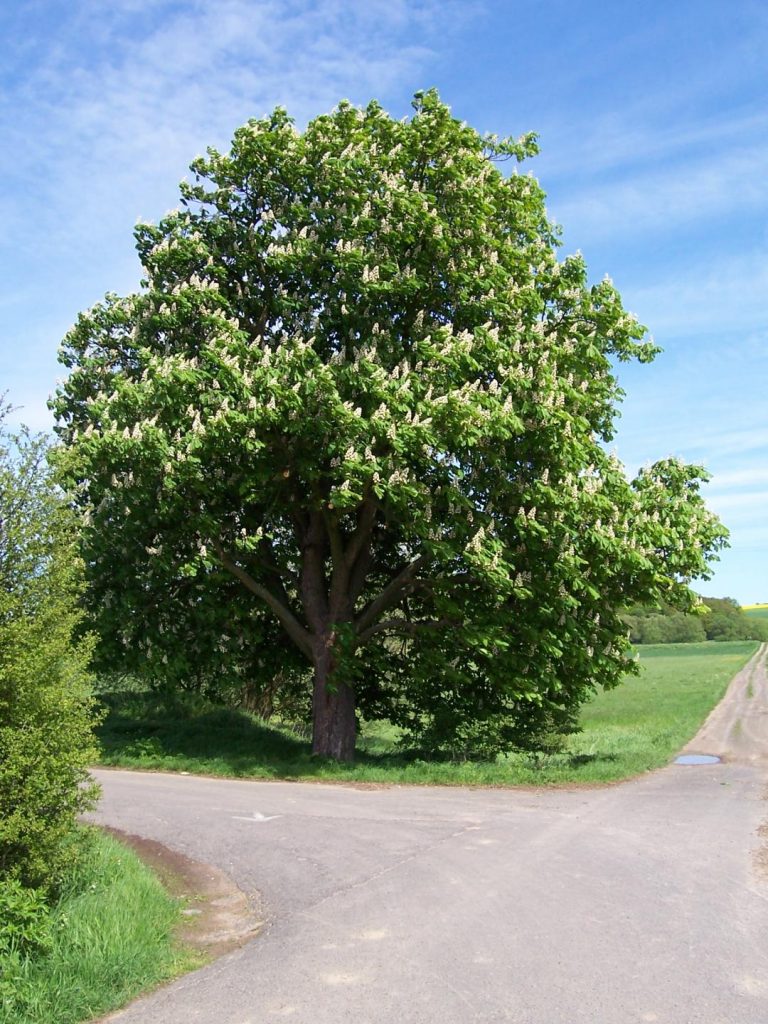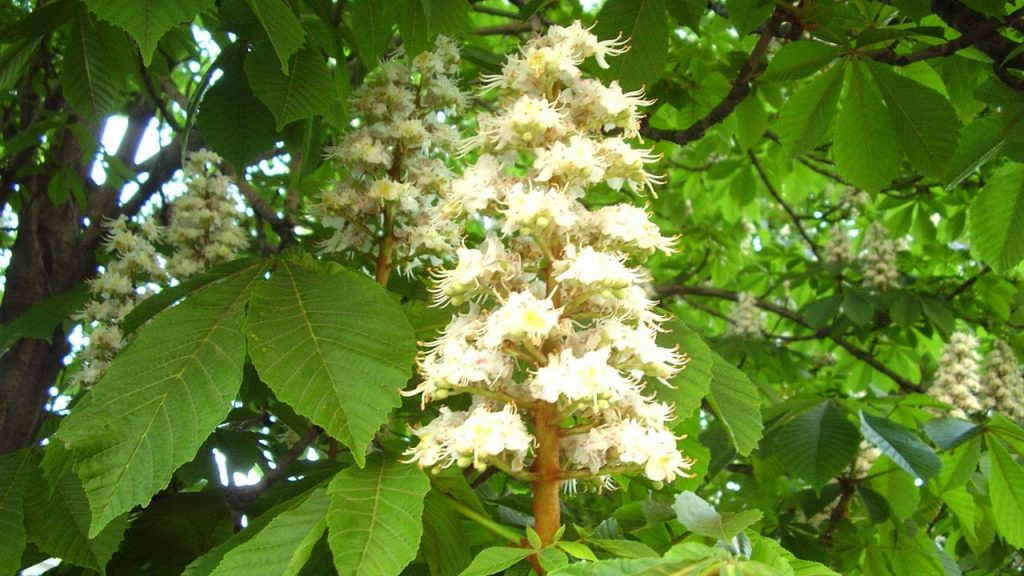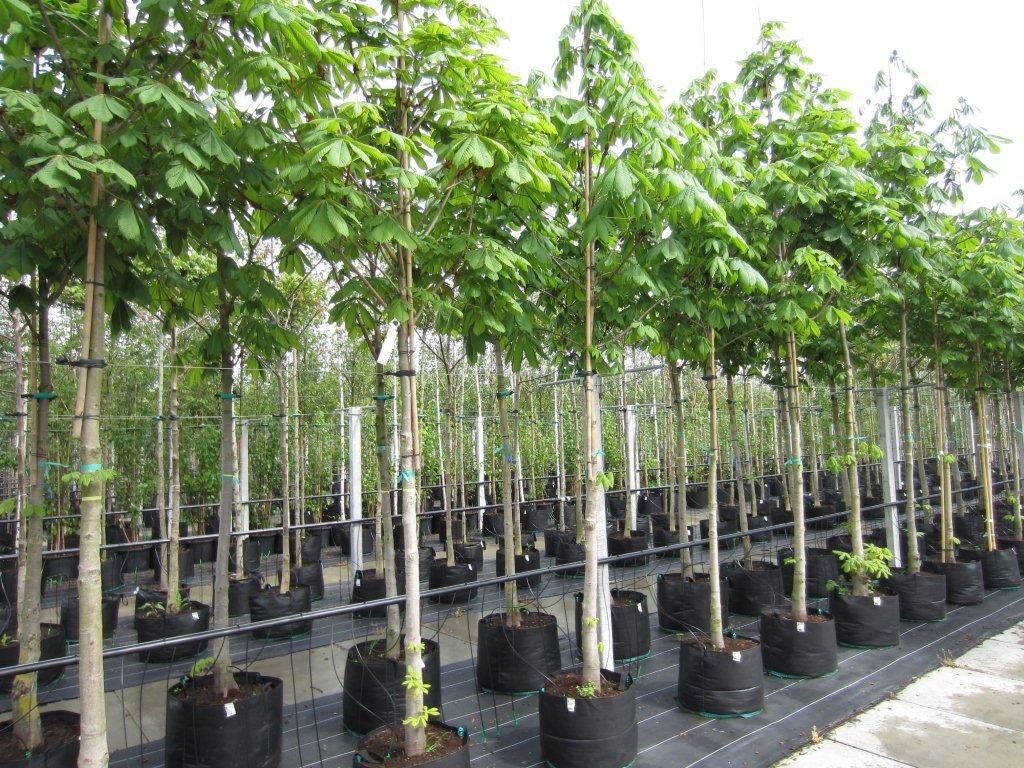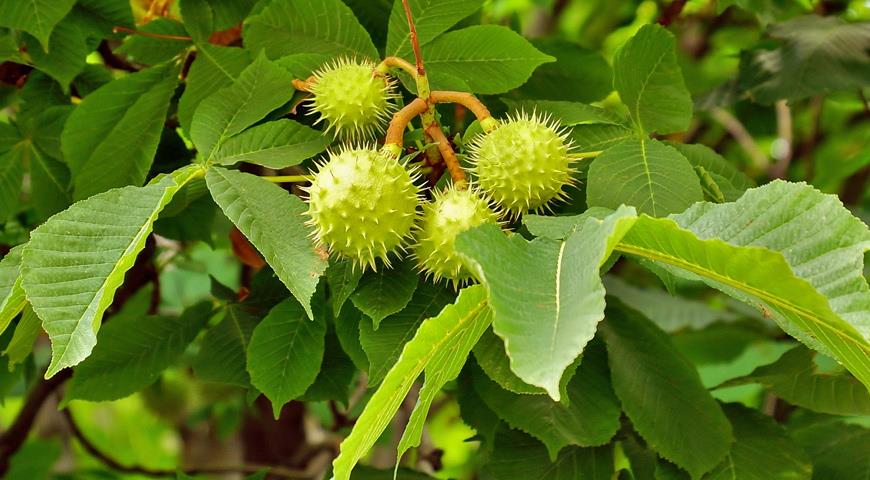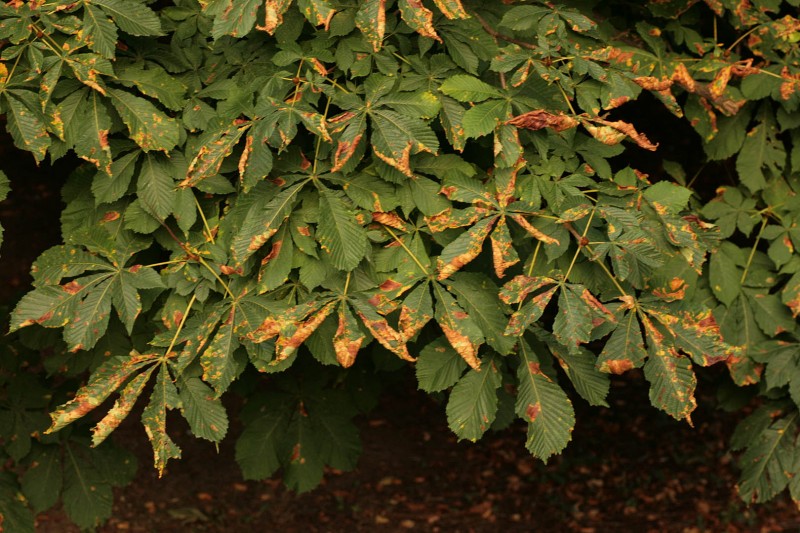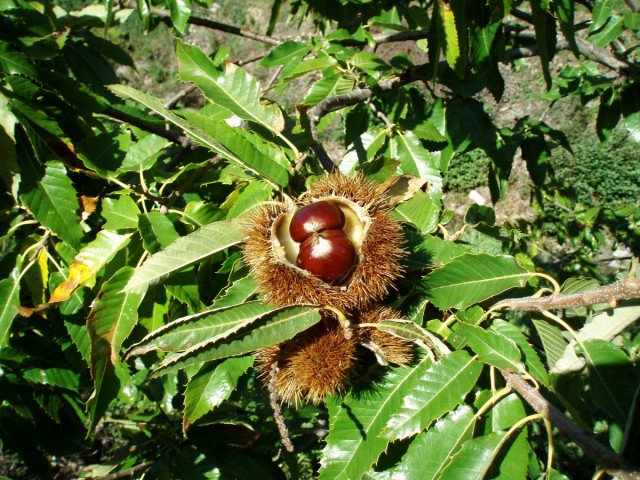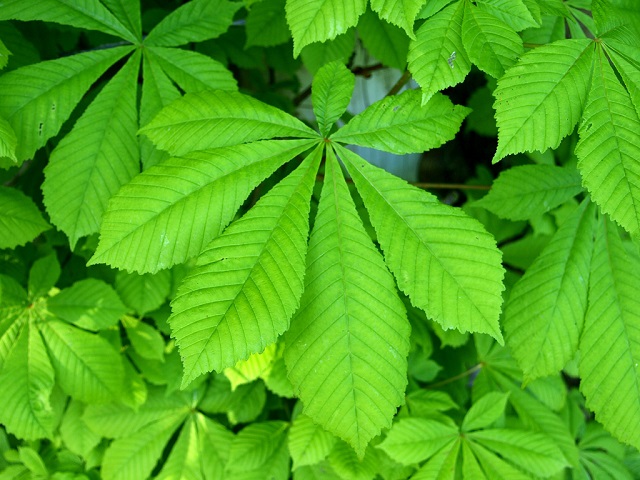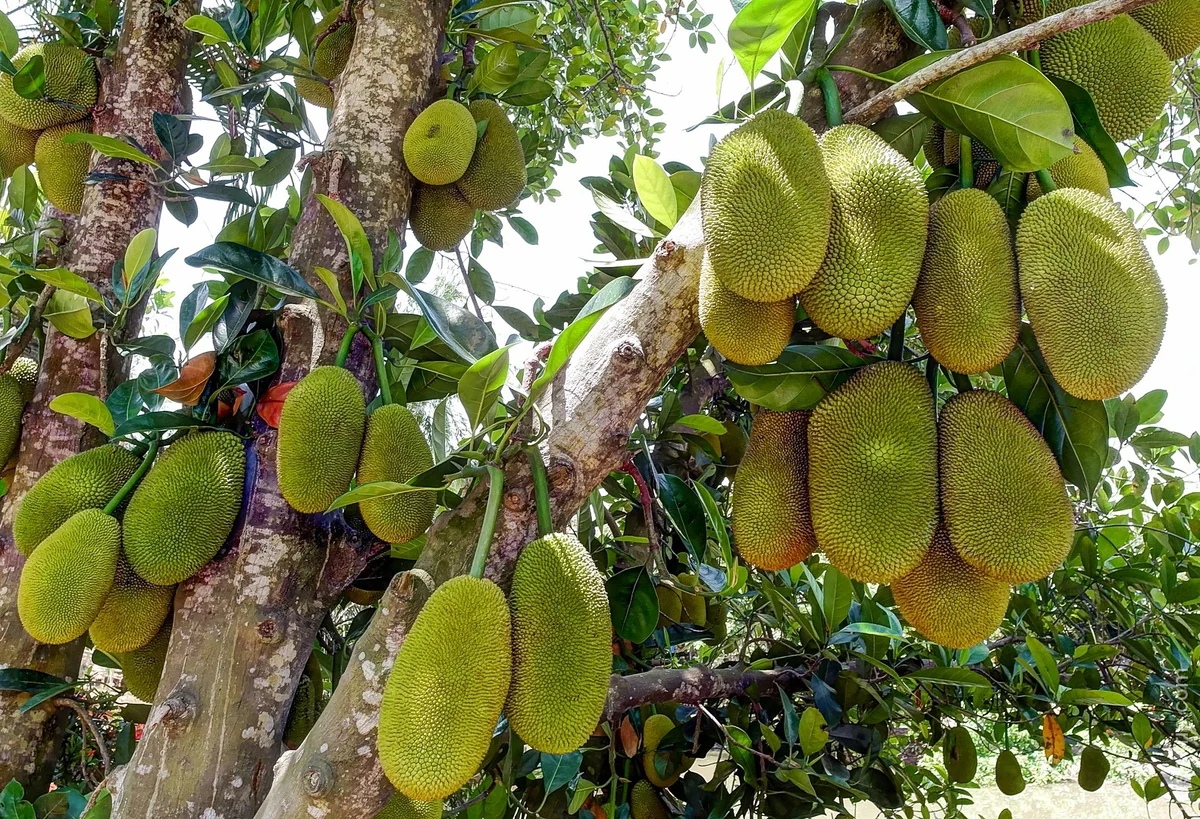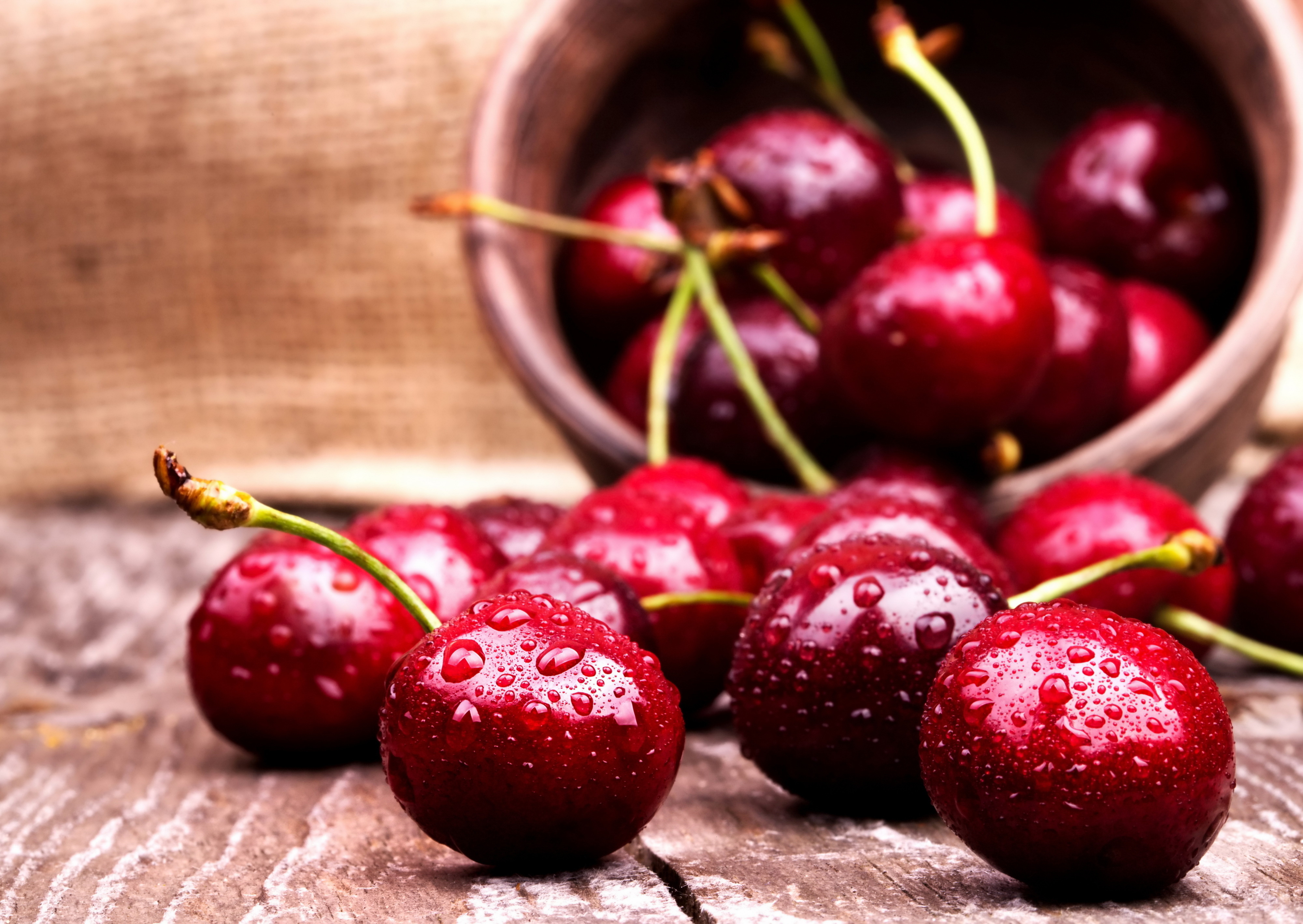Chestnut grew almost everywhere at the dawn of mankind, including Greenland. In Europe, it has been grown as an ornamental tree for over five centuries. Much later, the medicinal properties of chestnut became known. A densely crowned, deciduous tree that does not require special planting conditions and is easy to care for.
Content
Features of growing chestnut
Chestnut is a tall tree that can decorate a summer cottage. The umbrella crown gives a thick shade, and delicate flower candles delight every spring for 2 weeks. In autumn, fruit pods covered with green thorns appear. When ripe, they crack, and from there hard glossy brown nuts fall to the ground.
This perennial tree has many medicinal properties. Various parts of the plant contain coumarins, glycosides, tannins, vitamins C and thiamine, carotenoids, pectins, flavonoids. They contribute to the treatment of thrombosis, the elimination of edema, are useful in cardiovascular disorders, arthritis, anemia, bleeding and many other problems.
It grows wild in many southern countries, but it is often found in the middle lane as a garden and ornamental culture. Proper planting and caring for a chestnut tree is not as difficult as it might seem to a beginner.
Often on the Internet you can find information that chestnut is a variety oriental plane tree, which is not true. These are completely different trees from different families. The sycamore tree has characteristic maple-like leaves, a very specific trunk and an imperceptible flowering, unlike chestnut.
Having decided to plant this spreading tree in your garden, you need to take into account that for the normal development of its crown, space is needed: the distance to buildings, buildings or other green spaces should be at least 5 meters. Even grass does not grow under its dense crown, but this is an excellent protection from the scorching sun rays.
In what climate does chestnut grow
Despite its southern origin, the chestnut is quite winter-hardy. Under favorable conditions, some specimens survive for centuries. Thanks to the branched and powerful root system, the tree can grow even in rather harsh climates, requiring shelter for the winter only at a young age.
In summer, it can withstand 30 ° C heat, but the best temperature for it is moderate heat of 20 to 25 ⁰C.
With good snow cover, in winter, the tree survives twenty degrees of frost, but suffers from cold, piercing winds.
Chestnut also does not tolerate a gas-polluted atmosphere and dry winds. Therefore, it is often possible to observe withering and drying up foliage of trees on the streets of industrial cities in the midst of a hot summer.
Breadfruit, have you heard of this? An exotic plant that the inhabitants of Oceania first met. It is of high value due to the fact that it can replace ordinary bread:https://flowers.desigusxpro.com/en/derevya/hlebnoe-derevo-foto-opisanie.html
What soil is preferable for him
Horse chestnut is sun-loving and drought-resistant.Wet, fertile loams or chernozems with a neutral or slightly acidic reaction are preferred for it.
The soil should be loose and well-drained. It grows poorly on poor, quickly drying sandy soils.
Popular varieties
The most common representative of this plant in our country is the horse chestnut. In adulthood, it grows up to 30 meters, has large, finger-like (5 or 7) compound leaves with well-defined veins. Upward-pointing racemose inflorescences appear in May. They have double white, yellow or pink flowers with red spots in the center. The fruits ripen in September - October.
In addition to it, there are other types:
- Californian. It grows in the western United States, its height is up to 10 meters, and the flowers are white and pink.
- Meat red. Crimean variety with large racemose inflorescences of dark red color. The tree, which grows up to 30 meters, absolutely does not tolerate drought, loves abundant watering.
- Yellow... Eastern American variety with a pyramidal crown, yellow buds and golden toothed leaves. It is considered one of the most cold-resistant species. It blooms a little later than its relatives.
- Small-flowered. Shrub form with complex small leaves, painted on the underside in a grayish color. They grow up to 5 meters high.
- Pavia, or red chestnut. A shrub or tree native to the eastern United States. It grows up to 10 meters and is distinguished by rich red flowers and smooth fruits.
- Japanese. A tall, upright tree with very large leaves and yellow-white flowers. Its fruits are pear-shaped.
The Japanese generally have a lot of interesting plants. These include an incredibly beautiful shrub called Japanese quince or Chaenomeles:https://flowers.desigusxpro.com/en/derevya/ayva-yaponskaya-osobennosti-posadki-i-uhoda-foto-rasteniya.html
How to plant a chestnut tree
Planting a chestnut is a simple matter, but you should take into account the condition of the soil on the site. If the composition of the soil is unfavorable for this tree, the planting place is preliminarily prepared: they dig a hole and fill it with a mixture of three parts of sod land, two parts of humus and one part of sand.
Autumn or early spring is considered the best time for planting, these dates are not recommended to be shifted, because there is a possibility that the seedling will not have time to take root.
Three-year-old and slightly older specimens are excellent planting material.
The order of work:
- Dig a hole more than half a meter deep and wide.
- Humus, a glass of superphosphate are introduced into the soil. An excessively acidic reaction of the soil composition is neutralized with dolomite flour.
- The roots of the chestnut tree do not tolerate waterlogging, therefore, for good drainage, the bottom of the ditch is covered with a layer of about 15 cm, consisting of sand with the addition of fine gravel.
- The root collar is placed at ground level when planting.
- To prevent subsidence of the root collar, the pit is not only densely filled with a nutritious soil mixture, but also a small mound is made around the trunk.
- Each seedling is watered with 3-4 buckets of warm water. After planting, daily watering is practiced.
- For better rooting, the seedling is tied to a support. The support can be removed when the chestnut is rooted and the tree can withstand the winds.
Seedling care in the garden
Caring for a tree planted in a permanent place in the garden is simple. At a young age, you need to constantly take care of it, while a mature tree almost does not need care.
A newly planted tree should not be left under the hot rays of the sun, it can overheat and get severe burns.When growing chestnuts in the open sun and at high air temperatures in the first year of life, you should intensively water and additionally cover the chestnut tree.
After planting, the following agrotechnical measures are carried out during the season:
- Watering. For young specimens, it should be constant, while mature ones are watered only as needed. Better to use settled water. Water the plants at the same time - in the early morning or before sunset.
- Weeding. It is done only at first, since the overgrown dense crown of the tree does not create conditions for the appearance of extraneous vegetation in the near-trunk area.
- Mulching. To keep the ground around the chestnut loose and not dry out, it is mulched with a 10-centimeter layer of wood chips or peat with the addition of compost.
- Top dressing. Fertilization is a must-have ritual for achieving good tree growth. After wintering, manure and urea, ammonium nitrate and phosphorus-potassium fertilizers are used for feeding. In autumn, nitroammophoska is used for this. A layer of wood chips and peat mulch is also a beneficial option for additional feeding of young trees.
- Preparing for the winter. It is only needed in the first couple of years after planting. The trunk is wrapped in several layers of burlap, and the trunk circle is mulched. This prevents the bark from cracking in frost. The frost cracks that appear are treated with an antiseptic and covered with garden pitch.
- Pruning. It is necessary to stimulate a lush and beautiful crown. When pruning in spring, shoots that have grown from young trees are shortened by half. In summer, thin twigs are removed to avoid overgrowth of the crown. Be sure to leave at least five strong lateral shoots intact. The places where the branches were cut are covered with garden pitch. In adult trees, only spring sanitary pruning of dry and damaged branches is done.
Prevention and control of diseases and pests
Although the tree, traditional for landscaping city streets, rarely gets sick, but sometimes it suffers from fungal diseases, an invasion of beetles and other pests.
A diseased tree with dry, rusty leaves should be immediately sprayed with Bordeaux liquid or Fundazol, which helps out in almost all cases.
In recent decades, previously unknown pests have begun to attack chestnut trees - the chestnut, or Balkan moth. From it, at the height of summer, the leaves dry and fall off, blooming again by autumn. Then the chestnut begins to bloom late, and because of this, it meets the winter unprepared. This leads to its freezing and even death during wintering.

Escin, in combination with flavonoids found in chestnut fruits, prevents blood clots and strengthens the walls of blood vessels
It is difficult to deal with this pest; you have to inject a special chemical into the trunk of the affected tree. An effective preventive measure is the timely cleaning of fallen leaves, in which moth pupae prefer to spend the winter.
The tick is a dangerous enemy of the chestnut. To prevent its appearance, 2 times a month you can treat the tree with Karbofos or Fitoverm. Of the folk remedies, decoctions of dissected hogweed and black henbane are considered the most effective.
Detailed instructions for the use of Fitoverm:https://flowers.desigusxpro.com/en/uhod-za-rasteniyami/udobreniya/instrukciya-po-primeneniyu-fitoverm-otzyvy-potrebiteley.html
Problems arising in the cultivation of chestnuts and their solution
Growing chestnut trees in most cases is a little hassle. But sometimes you have to face some complications:
- Leaf spot. It is perforated, black, brown or reddish brown. With this phenomenon, it is important to collect all affected leaves and burn them. A diseased tree needs extra feeding, reducing the frequency of watering. Its additional protection will be a cover with a film tied to several pegs.
- Due to excessive heat or nitrogen oversaturation against the background of a deficiency of phosphorus and potassium, the tree may appear powdery mildew... In this case, treatments are carried out with Topsin, Fundazol or Fitosporin-m.
- Necrosis. Its causes may be temperature drops or mechanical damage to the plant. This problem is especially terrible for young specimens. The place of damage is cut out, the wounds are disinfected and covered with garden varnish. A measure of prevention of such a painful phenomenon for a tree is to whitewash its trunk in spring and autumn.
- Bark rot is a serious problem, and there is no escape from it. When it appears, the chestnut is cut down and burned. Preventive methods: liming the soil and spraying the plant with systemic fungicides.
Seed propagation
The forums discuss the cultivation of chestnuts from nuts. This is a challenging, but affordable and educational method of getting a new tree in your garden.
When growing seedlings from nuts, to increase the effectiveness of the event, at least 5-10 pieces must be planted at the same time. There is always the possibility of planting unripe or damaged nuts that will not sprout normally.
To protect a young tree from insects, it is preventively treated with antiparasitic drugs.
The most interesting tips are:
- Nuts are planted in flower beds, for example, next to tulips. At the same time, dry grass is laid in the grooves in several layers, and the top is covered with earth.
- Spraying with Fufanon helps to save young twigs from aphids.
- From mice, it is effective to lubricate nuts before lowering them into the ground with a clay mash with the addition of red pepper, tar or kerosene. Then you can spray the soil with kerosene at the planting site.
- For better growth, young shoots should be treated monthly with Mycorrhiza, Trichodermin or Fitosporin preparations. This is additional nutrition and protection of plants from various pests and infections.
- When planting chestnuts with seeds, it is better to immediately choose a permanent place for them. This prevents damage to the root system during subsequent transplantation and thereby increases their resistance during unfavorable wintering.
Gardeners reviews
I advise you to transplant chestnuts in early autumn, when the heat has already subsided, but it will still be warm enough. Transplant with a clod of earth (if before that there was a heat and the earth is crumbling, water it a couple of days before transplanting so that the earth "grabs" and a clod of earth around the roots holds). Be sure to spill well after transplanting. And a week later again. You can water with Kornevin when planting. I do not recommend trimming the central stem. Chestnut is not a bush, it should have one trunk. He is naturally laid down to be even)
I have a horse chestnut growing. He is already 5 years old. It grew 1 m from a nut that I planted for a test (if it grows, it won't grow). He is very attractive even without flowers (the sun is not enough for him). It grows in front of the dacha, along the path. I expect that someday he will give a shadow on the house and on the car, near which he now found himself (when I was planting, I did not think about the car).
Many gardening enthusiasts have tried to grow horse chestnut in Siberia, but these attempts have led nowhere. The trees, despite their growth and even fully matured shoots by autumn, froze over the winter. Or completely frozen out.
As well as attempts to grow a seedling from a nut. Such seedlings grow and overwinter while small, after, when their growth increases, they freeze slightly and become like a bush.
We did this. In the fall, they simply planted the chestnuts in a row. At a distance of about 50 cm from each other, half a bayonet.If the ground is dry, pour water into the hole before planting. Plant in the fall, they need to survive the cold. That's all. In the spring, out of 9 planted chestnuts, 7 have risen. Watered, loosened. A year later, 2 seedlings were planted near the yard, the rest were distributed.
When growing a horse chestnut tree or its varieties, you need to be patient, it does not grow quickly. With careful care, after a dozen years, having significantly outstripped all the surrounding garden trees in growth, it will become protection from the summer heat thanks to its thick, juicy and delicate foliage. If necessary, this plant can become a healer for many diseases.
